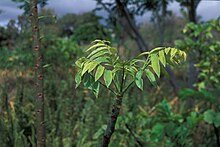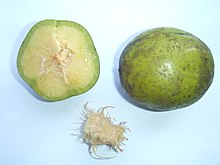Spondias dulcis
From Wikipedia, the free encyclopedia
(Redirected from Ambarella)
"Ambarella" redirects here. For other uses, see Ambarella (disambiguation).

| Spondias dulcis | |
|---|---|
| Spondia dulcis | |
| Scientific classification | |
| Kingdom: | Plantae |
| (unranked): | Angiosperms |
| (unranked): | Eudicots |
| (unranked): | Rosids |
| Order: | Sapindales |
| Family: | Anacardiaceae |
| Genus: | Spondias |
| Species: | S. dulcis |
| Binomial name | |
| Spondias dulcis L. | |
Spondias dulcis (or its alternative binomial, Spondias cytherea), ambarella, hog plum is an equatorial or tropical tree, with edible fruit containing a fibrous pit. It is known by many names in various regions, including pomme cythere in Trinidad and Tobago,[1] Dominica, Guadeloupe and Martinique,[2]June plum in Bermuda and Jamaica,[1] juplon in Costa Rica, jobo indio in Venezuela, cajá-manga or cajarana in Brazil, and quả cóc in Vietnam. Kedondong in Indonesia
Description
This fast-growing tree can reach up to 60 ft (18 m) in its native homeland of Melanesia through Polynesia; however, it usually averages 30 to 40 ft (9–12 m) in other areas. Spondias dulcis has deciduous, pinnate leaves, 8 to 24 in (20–60 cm) in length, composed of 9 to 25 glossy, elliptic or obovate-oblongleaflets 2.5 to 4.0 in (6.25–10 cm) long, finely toothed toward the apex.[3] The tree produces small, inconspicuous white flowers in terminal panicles, assorted male, female. Its oval fruits, 2.5 to 3.5 in (6.25–9 cm) long, are long-stalked and are produced in bunches of 12 or more. Over several weeks, the fruit fall to the ground while still green and hard, turning golden-yellow as they ripen. According to Morton (1987), “some fruits in the South Sea Islands weigh over 1 lb (0.45 kg) each”.
[edit]Habitat
Native to Melanesia through Polynesia, S. dulcis has been introduced into tropical areas across the world. The species was introduced into Jamaica in 1782, and, among other places, is also cultivated in Panama, Cuba, Haiti, the Dominican Republic, and also from Puerto Rico to Trinidad, and easternSucre, in Venezuela. Although the United States Department of Agriculture received seeds from Liberia in 1909, S. dulcis has yet to become popular in America.
[edit]Uses
Spondias dulcis is most commonly used as a food source. Its fruit may be eaten raw; the flesh is crunchy and a little sour. In Indonesia and Malaysia,S. dulcis is eaten with shrimp paste (a thick, black, salty-sweet sauce, called hayko in Chinese Southern Min dialect). It is an ingredient in rujak" in Indonesia or 'rojak in Malaysia, and may also be juiced, which is called kedondong"' juice in Indonesia, umbra juice in Malaysia, or balonglong juice inSingapore.
Alternative food uses include cooking the fruit into a preserve, similar in consistency to apple butter, sauce flavoring, soups, and stews.

No comments:
Post a Comment